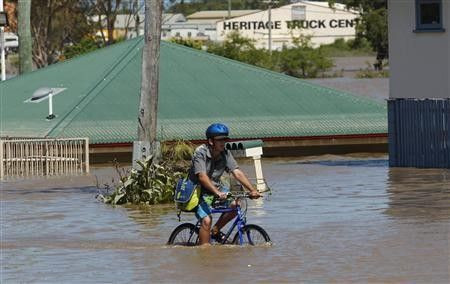Queensland braces for more storms but also sees silver lining in the rain

Australia's relief over the years of drought being finally broken by rain in December was short-lived as its states now brace for flooding which the government has described as biblical.
Queensland has been hit hard by thunderstorms in the past couple of weeks, leading to several towns such as Chinchilla, Theodore and Dalby being evacuated. Several other towns like Rockhampton were almost entirely cut off by rising floodwaters.
The government has rushed aid to the flood-affected areas but the state is now bracing for more thunderstorms.
St George, located in Southern Queensland, about 500 kms inland from the state's capital, Brisbane, is expected to be hit next. Flood waters are expected to peak in Rockhampton, which lies on the banks of the Fitzroy river - the largest river catchment flowing to the eastern coast of Australia.
The Bureau of Meteorology says the river should see a strong moderate flood of eight metres this week, with the potential for a major flood level of 8.5 metres next week, according to Sydney Morning Herald.
Cyclone Tasha hit the Queensland area, which is mainly rural and dependent on mining and agriculture, two weeks ago. Merely three days after Christmas, when the region saw about 150-250 mm of rainfall, three towns were declared as disaster areas and evacuation processes were started.
Several people have submitted voluntarily to evacuation, though the declaration of the disaster area gives rescuers power to force people to move to safer areas.
However, the floods have already claimed 10 victims. The last one occurred on Monday when a car was washed off a causeway at Aramac, in Western Queensland.
While the rainfall is expected to taper down soon, the dangers of flash floods and hailstones continue to persist.
The damage from the floods is expected to top $1 billion, according to estimates from the state government. Much of it will be used to shore up the roads that were damaged during floods. The damages to private property is not included in the current estimate.
Anna Bligh, Queensland's premier, called for an emergency cabinet meeting on Wednesday to decide on the rebuilding process.
Much of Queensland's major industries and shipments of coal, wheat and sugar have been hurt by the floods.
The floods have cost the coal companies in the region about $1 billion in lost productions, according to the Queensland Resources Council, ABC News reported.
About a dozen mines have been flooded, while others are running on reduced capacity, the report ssaid, adding that it would be hard work to get those back into full production.
Mines have a lot of water to deal with and so we'll be talking to the Queensland Government about some practical measures to safely get rid of excess water, QRC CEO Michael Roche told ABC News.
WHEAT PRICES
Meanwhile, wheat prices soared in the market on the news that up to half of Australia's current wheat harvest could be downgraded to animal feed, raising concerns that the current wheat shortage in the world could be exacerbated.
Crop analysts and farmers said up to 50 percent of the 2010-11 crop would be downgraded, according to a report on Reuters.
The largest grain handler in eastern Australia, GrainCorp, said on Tuesday that 10.7 million tonnes of wheat had been received at its east coast terminals to date, including 1.3 million tonnes in Queensland, the report said.
But it said flooding had stopped all rail transport of grain to its Queensland export terminals with rail shipments not likely to resume for up to two weeks, it added.
Reports of such shortages create further fears of another year of food grain shortages across the world. In 2010, much of Russia crop was wiped out by severe drought and fires, leading the world's largest wheat exporter to ban further exports till the next crop, which is expected mid-2011.
China and Pakistan, other exporters of food grain, saw severe floods, wiping out more than half the crop. The food shortages resulted in spiking food grain prices, leading to riots in some places like Mozambique.
AFTER THE FLOODS
However, some citizens of New South Wales (NSW) and Queensland remain hopeful that the rains will slow down but not stop completely.
The two states have been facing severe drought for more than a decade.
More than 80 percent of NSW was facing a drought at the beginning of last year, leading to water restrictions up to Level 3, where no sprinklers or swimming pools were allowed.
Queensland was facing much dire circumstances, with the government imposing the highest level of water restrictions in the country. The government even implemented a four-minute shower policy, which was aimed at making people personal responsible for saving water, under the new Level five water restrictions three years ago.
''We needed a good flood and rains after a long drought. 'Hopefully now the drought's broken it'll stay broken for a while, Andrew Dumaresq, who runs a 2200-hectare wheat and canola farm outside Wagga Wagga, told SMH.
While Mr Dumaresq is rushing to harvest his wheat crop weeks late, his children, Chloe, 8, and Angus, 9, are enjoying the novelty of an overflowing creek they had never before seen water in.
''We tried to tell them, but the kids didn't believe it until they saw it,'' he said.
The floods have helped boost confidence of many farmers, whose wheat production had dwindled in the past few years due to the lack of rains.
Weather forecasts currently indicate that the wet weather will continue through the summer, before La Nina breaks down in March and weather patterns returned to normal, SMH said.
© Copyright IBTimes 2024. All rights reserved.





















